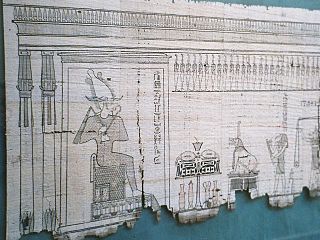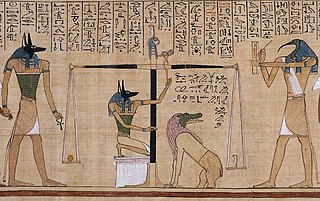
Anubis, also known as Inpu, Inpw, Jnpw, or Anpu in Ancient Egyptian, is the god of funerary rites, protector of graves, and guide to the underworld, in ancient Egyptian religion, usually depicted as a canine or a man with a canine head.

Ammit was an ancient Egyptian goddess with the forequarters of a lion, the hindquarters of a hippopotamus, and the head of a crocodile—the three largest "man-eating" animals known to ancient Egyptians. In ancient Egyptian religion, Ammit played an important role during the funerary ritual, the Judgment of the Dead.

The Duat, also called Amenthes or Te, is the underworld in ancient Egyptian mythology. It has been represented in hieroglyphs as a star-in-circle: 𓇽. The god Osiris was believed to be the lord of the underworld. He was the first mummy as depicted in the Osiris myth and he personified rebirth and life after death. The underworld was also the residence of various other gods along with Osiris.

The ancient Egyptians believed that a soul was made up of many parts. In addition to these components of the soul, there was the human body.

The Book of the Dead is the name given to an ancient Egyptian funerary text generally written on papyrus and used from the beginning of the New Kingdom to around 50 BC. "Book" is the closest term to describe the loose collection of texts consisting of a number of magic spells intended to assist a dead person's journey through the Duat, or underworld, and into the afterlife and written by many priests over a period of about 1,000 years. In 1842, the Egyptologist Karl Richard Lepsius introduced for these texts the German name Todtenbuch, translated to English as 'Book of the Dead'. The original Egyptian name for the text, transliterated rw nw prt m hrw, is translated as Spells of Coming Forth by Day.

Sukhavati is the pure land of Amitābha in Mahayana Buddhism. It is also called the Land of Bliss or Western Pure Land and is the most well-known of Buddhist pure lands due to the popularity of Pure Land Buddhism in East Asia.

Memento mori is an artistic or symbolic trope acting as a reminder of the inevitability of death. The concept has its roots in the philosophers of classical antiquity and Christianity, and appeared in funerary art and architecture from the medieval period onwards.

In some schools of Buddhism, bardo or antarābhava is an intermediate, transitional, or liminal state between death and rebirth. The concept arose soon after Gautama Buddha's death, with a number of earlier Buddhist schools accepting the existence of such an intermediate state, while other schools rejected it. The concept of antarābhava, an intervening state between death and rebirth, was brought into Buddhism from the Vedic-Upanishadic philosophical tradition. Later Buddhism expanded the bardo concept to six or more states of consciousness covering every stage of life and death. In Tibetan Buddhism, bardo is the central theme of the Bardo Thodol, the Tibetan Book of the Dead, a text intended to both guide the recently deceased person through the death bardo to gain a better rebirth and also to help their loved ones with the grieving process.

The Bardo Thodol, commonly known in the West as The Tibetan Book of the Dead, is a terma text from a larger corpus of teachings, the Profound Dharma of Self-Liberation through the Intention of the Peaceful and Wrathful Ones, revealed by Karma Lingpa (1326–1386). It is the best-known work of Nyingma literature. In 1927 the text was one of the first examples of both Tibetan and Vajrayana literature to be translated into a European language and arguably continues to this day to be the best known.

The ancient Egyptians had an elaborate set of funerary practices that they believed were necessary to ensure their immortality after death. These rituals included mummifying the body, casting magic spells, and burials with specific grave goods thought to be needed in the afterlife.

Sky burial is a funeral practice in which a human corpse is placed on a mountaintop to decompose while exposed to the elements or to be eaten by scavenging animals, especially carrion birds like vultures and corvids. Comparable excarnation practices are part of Zoroastrian burial rites where deceased are exposed to the elements and scavenger birds on stone structures called Dakhma. Sky burials are endemic to Tibet, Qinghai, Sichuan, and Inner Mongolia, as well as in Mongolia, Nepal, Bhutan, and parts of India such as Sikkim and Zanskar. The locations of preparation and sky burial are understood in the Vajrayana Buddhist traditions as charnel grounds. Few such places remain operational today, as the Chinese Communist Party initially banned the practice completely during the Cultural Revolution as feudal superstition, and continues to restrict the practice due to its allegations of decimation of vulture populations.

The opening of the mouth ceremony was an ancient Egyptian ritual described in funerary texts such as the Pyramid Texts. From the Old Kingdom to the Roman Period, there is ample evidence of this ceremony, which was believed to give the deceased their fundamental senses to carry out tasks in the afterlife. Various practices were conducted on the corpse, including the use of specific instruments to touch body parts like the mouth and eyes. These customs were often linked with childbirth, which denoted rebirth and new beginnings. For instance, cutting bloody meat from animals as offerings for the deceased signified the birthing process, which typically involves blood, and represented the commencement of a new life. Additionally, tools like the peseshkef, which resembled the tail of a fish and were originally employed for cutting infants' umbilical cords, further emphasized the idea of "rebirth".

The Ars moriendi are two related Latin texts dating from about 1415 and 1450 which offer advice on the protocols and procedures of a good death, explaining how to "die well" according to Christian precepts of the late Middle Ages. It was written within the historical context of the effects of the macabre horrors of the Black Death 60 years earlier and consequent social upheavals of the 15th century. The earliest versions were most likely composed in southern Germany. It was very popular, translated into most West European languages, and was the first in a western literary tradition of guides to death and dying. About 50,000 copies were printed in the incunabula period before 1501 and further editions were printed after 1501. Its popularity reduced as Erasmus's treatise on preparing for death became more popular.

The four sons of Horus were a group of four deities in ancient Egyptian religion who were believed to protect deceased people in the afterlife. Beginning in the First Intermediate Period of Egyptian history, Imsety, Hapy, Duamutef, and Qebehsenuef were especially connected with the four canopic jars that housed the internal organs that were removed from the body of the deceased during the process of mummification. Most commonly, Imsety protected the liver, Hapy the lungs, Duamutef the stomach, and Qebehsenuef the intestines, but this pattern often varied. The canopic jars were given lids that represented the heads of the sons of Horus. Although they were originally portrayed as humans, in the latter part of the New Kingdom, they took on their most distinctive iconography, in which Imsety is portrayed as a human, Hapy as a baboon, Duamutef as a jackal, and Qebehsenuef as a falcon. The four sons were also linked with stars in the sky, with regions of Egypt, and with the cardinal directions.
The Book of the Dead is an ancient Egyptian funerary text.
Among Buddhists, death is regarded as one of the occasions of major religious significance, both for the deceased and for the survivors. For the deceased, it marks the moment when the transition begins to a new mode of existence within the round of rebirths. When death occurs, all the karmic forces that the dead person accumulated during the course of their lifetime become activated and determine the next rebirth. For the living, death is a powerful reminder of the Buddha's teaching on impermanence; it also provides an opportunity to assist the deceased person as they transition to a new existence. There are several academic reviews of this subject. In Buddhism, death marks the transition from this life to the next for the deceased.
In Tibetan Buddhism and Bön, Zhitro or Shitrozab-chos zhi khro dgongs pa rang grol, also known as kar-gling zhi-khro refers to a cycle of teachings revealed by the terton Karma Lingpa and traditionally believed to have been written by Padmasambhava. The practices involve a mandala of 100 peaceful (zhi) and wrathful (khro) tantric deities and associated teachings and tantric practices which focus on those deities which represent the purified elements of the body and mind. These hundred peaceful and wrathful deities are believed to manifest to a deceased person following the dissolution of the body and consciousness whilst they are in the intermediate state, or bardo, between death and rebirth. The Bardo Thodol, commonly known in the West as "The Tibetan Book of the Dead", forms one section of Karma Lingpa's Zhitro cycle. The Zhitro teachings are closely related to the Guhyagarbha Tantra and are considered an Inner Tantra.

Ancient Greek funerary practices are attested widely in literature, the archaeological record, and in ancient Greek art. Finds associated with burials are an important source for ancient Greek culture, though Greek funerals are not as well documented as those of the ancient Romans.
The use of death horoscopes in Tibetan Buddhism is an old practice that still sees application today. There are several types of horoscopes used in this religion, including a birth horoscope, a life forecast, an annual horoscope, a marriage horoscope, and a death horoscope. When casting the death horoscope, Tibetan Buddhists place great importance on the corpse, especially within the first three days following its death. There are several purposes for a death horoscope, and carrying out this practice must be done carefully. Additionally, a death horoscope is intended as a loving act for the dead, and a precautionary measure for the family of the deceased. Many Tibetans believe that when a death occurs within the family, other family members' lives are jeopardized, so this practice may be considered essential to both the living and dead. Tibetan Buddhists also believe that their deceased loved ones may spend a short period in hell to pay for sins in their past life.

Ancient Egyptian afterlife beliefs were centered around a variety of complex rituals that were influenced by many aspects of Egyptian culture. Religion was a major contributor, since it was an important social practice that bound all Egyptians together. For instance, many of the Egyptian gods played roles in guiding the souls of the dead through the afterlife. With the evolution of writing, religious ideals were recorded and quickly spread throughout the Egyptian community. The solidification and commencement of these doctrines were formed in the creation of afterlife texts which illustrated and explained what the dead would need to know in order to complete the journey safely.














